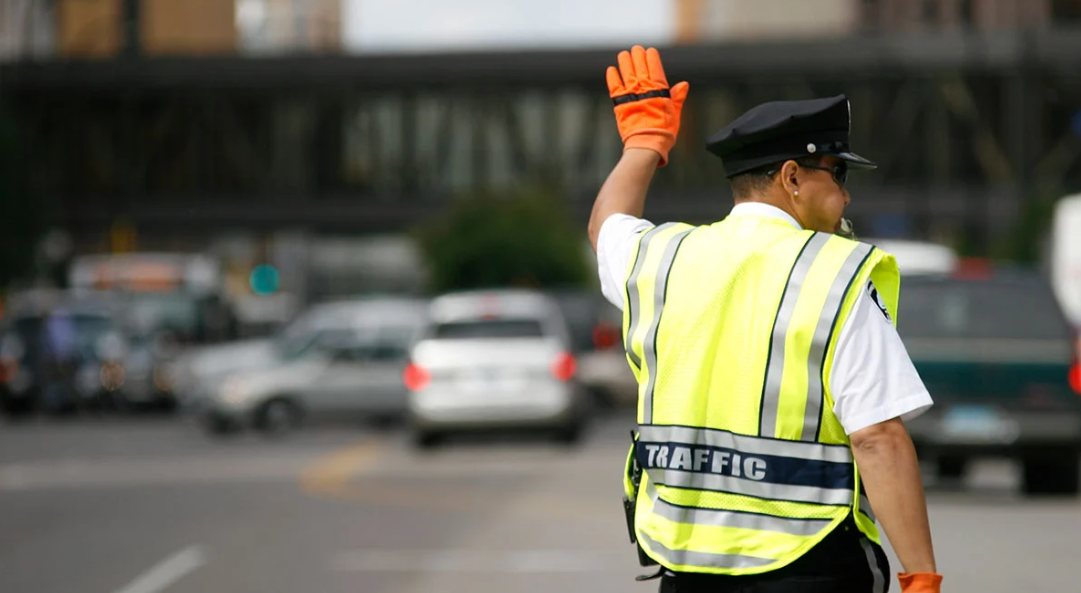Directing traffic may be the least understood or ignored risk/hazard facing emergency services professionals? Consider the threat posed by today’s distracted driver, and the aggressive tendencies of immature drivers. All too often, these kinds of drivers are responsible for a majority of traffic collisions.
Today’s public safety officer while directing traffic must be at their best, keenly focused and aware of what is around them, and never turning their back on close by traffic. When you least expect a problem, along comes the out-of-control DUI or a speeding, reckless driver and you’re life could be over. Since 1998, 31 law enforcement officers in America alone have been hit and killed by motor vehicles. Do you believe we may have a safety problem for our personnel during traffic control?
In the summer of 1984, while working for the Kenner Police Department in Louisiana, I responded to a major power outage, an incident requiring the dispatch of six police officers to the dangerous intersection of Williams Blvd., and Veterans Highway for traffic control. This intersection on a normal day is bad enough, a congested nightmare even with working traffic signals. Without traffic signals, you can appreciate the dangers we were facing that evening? With the traffic lights not working, it was pitch black, except for the glow of airplanes flying overhead with their landing lights on.
At the busy Moisant Airport, an elevated runway passes directly over busy Veteran’s Highway. And for some drivers, this image causes an illusion of approaching aircraft may hit vehicles on the highway. Too often, a startled driver may suddenly apply their brakes, causing a potential for a chain reaction collision.
With the parish lights out in a wide area and the airport operating on auxiliary power, provided an eerie site to behold. The horror of this night intensified by knowing we did not have reflective vests to wear. To better understand this scenario, you should know that Veterans highway runs East/West, and Williams Blvd., North/South: Each having a total of six lanes, three for eastbound, three for westbound, three for northbound, and three for southbound. For safety sakes, we had to literally surround ourselves in a circle of burning road flares. Considering the hazards of moving traffic and poor visibility, we had to keep our senses aware of what was around us.
Looking back on that scary night – all six of us were fortunate that no one was hurt during this challenging ordeal. That doesn’t mean we were not busy dodging or jumping out of the way of inattentive drivers. I don’t believe I have ever yelled so much as I did that night, I still remember this hair raising assignment as if it were just yesterday.
DRIVER AROUSAL
People sitting in traffic jams can quickly become unsettled and jittery, setting off a negative reaction about being held up, delayed in traffic. Sitting and waiting without getting overly anxious and impatient is hard to overcome for most drivers. I’m sure, we’ve all experienced this kind of “stuck in traffic reflex” at one time or another.
When directing traffic, you have to be extremely careful and anticipate that inattentive driver – who is doing everything except paying close attention to what’s in front of them. And about the time you relax your guard, here comes a speeding driver busting the intersection on a red light. Standing in and around moving traffic is a very serious matter, and one not to be taken lightly.
Last year in Louisiana, we lost a motor officer who was escorting a long funeral procession. And as fate would have it, an impatient driver waiting in cross traffic sees a lull in the procession. Needless to say, she pulls out in front of the approaching police officer and hits him. Tragically, a 28 year old officer died that day, all because a driver became impatient.
DRIVER TESTING
It’s no secret that we have a variety of “bad drivers” that are able to get licensed. You wonder how they’re able to beat the licensing system? Case in point, last year as I was getting my drivers license renewed, an elderly lady in her late 70’s or early 80’s, walked into the drivers license bureau with a hand held walker. You had to feel sympathy, she could not even bend over to read the electronic eye chart. So the drivers license examiner tells her to proceed to the eye chart in the rear of the building. And what happened next, was enough to unnerve any sane person. As she was heading to the rear of the building, she suddenly turned right and directly into the wall, her companion quickly took her hand and yelled in her ear – they said turn right not left. As the elderly lady stood before the eye chart, the examiner allowed her to get extremely close, as she called out all of the letters in reverse. After which, the Driver’s License person told her to sit on the bench and smile for the camera. I only mention this to raise awareness about the kind of drivers on the road, young and old. And so you see, driver testing is another separate discussion.
And when directing traffic, don’t forget, we have have no idea about any driver’s qualifications or capabilities. So please, take a defensive posture and treat all drivers on the road with caution, it could save your life.
Possibly, we need more emphasis on driver education and licensing about obeying the directions of police officers and firefighters charged with traffic control. The requirement that drivers entering an accident/crash scene do so with extreme caution, and violator’s who don’t – will face severe fines/punishment.
TRAINING OUR OWN?
Are we doing enough to train our Police, Fire/EMS personnel in safe traffic control procedures? Should there be more rigid training and certification standards for all personnel to pass? Should we allow untrained emergency responders to direct traffic?
I’m very interested in your point of view, and what you believe we can do to in the public safety sector to reduce our chances of getting hurt while directing traffic.











